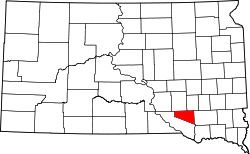Douglas County | |
|---|---|
 Douglas County Courthouse in Armour | |
 Location within the U.S. state of South Dakota | |
 South Dakota's location within the U.S. | |
| Coordinates: 43°23′N98°22′W / 43.39°N 98.36°W | |
| Country | |
| State | |
| Founded | 1873 (created) 1882 (organized) |
| Named after | Stephen A. Douglas |
| Seat | Armour |
| Largest city | Armour |
| Area | |
• Total | 434 sq mi (1,120 km2) |
| • Land | 432 sq mi (1,120 km2) |
| • Water | 1.9 sq mi (5 km2) 0.4% |
| Population (2020) | |
• Total | 2,835 |
• Estimate (2024) | 2,849 |
| • Density | 6.5/sq mi (2.5/km2) |
| Congressional district | At-large |
| Website | douglas |
Douglas County is a county in the U.S. state of South Dakota. As of the 2020 census, the population was 2,835. [1] Its county seat is Armour. [2] The county was established in 1873 and organized in 1882. [3] It is named for Stephen Douglas, [4] Illinois political figure.
